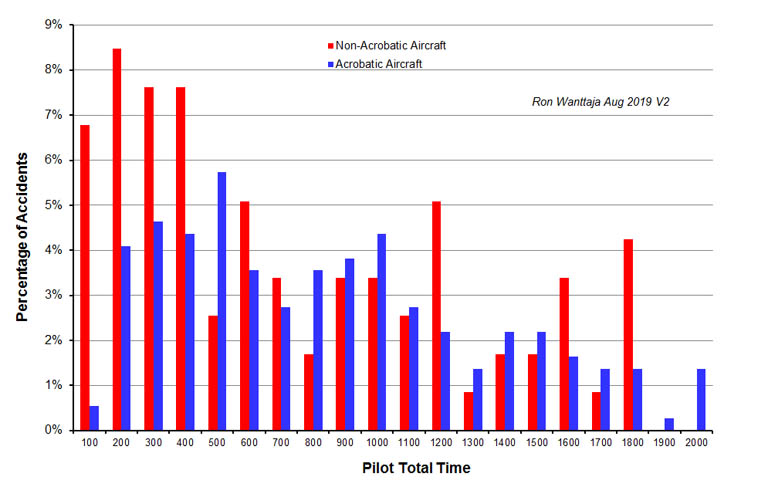Note... this has been UPDATED with more data. See Post #5.
------------------------------------------------------------------------------
For those who don't know me, I do a lot of statistical analysis of homebuilt aircraft accidents. Wes Liu suggested that I take a look at aerobatics-related accidents, specifically those that occur in airplanes not approved for aerobatics, and to low-time pilots trying to teach themselves aerobatics.
Ran some analyses over the weekend, and post addresses the results. But I'm a Systems Engineer by trade, so I have to document the methodology, first.
I used my copy of the NTSB accident database, and the accidents I examined ran from 1982 through 2017. I ran a search for "Aerobat*" in both the Probable Cause and Narrative sections. In my experience examining homebuilt accidents, the investigators would use terms like "Loop" or "Roll", but would also use the word "Aerobatics" at some point in the description. I included planes with both Standard and Special airworthiness.
This produced 795 "hits." However, the use of the word "Aerobatic" in the description does not mean the plane had an accident while performing aerobatics... often, it was a mere description of the aircraft type ("...the aerobatic aircraft had been purchased two years earlier...."). These accidents were eliminated.
The next step was to eliminate cases where the fact that aerobatics were involved was not a major factor in the accident. This eliminated instances like landing accidents that occurred after practicing aerobatics, etc. I made a judgement call in cases where mechanical failure manifested itself during the performance of aerobatics. If the failure was powerplant related, I eliminated it, but kept cases of structural failure. This last was for obvious reasons, but in a few cases, the root cause of the structural failure was a construction issue...these were eliminated as well.
I also eliminated accidents that occurred at air shows.
With this winnowing-out completed, I had 486 accidents left. The next stage was to identify those which were approved for acrobatics, and those that were not. This was not all that simple. Technically, most homebuilts can legally perform aerobatics (there are a few, like most Fly Babies, that have aerobatics prohibited in the operating limitations). But there are some that really aren't intended for acro. So I flagged these as "non-acrobatic aircraft."
Similarly, many older production airplanes can legally perform aerobatics simply because the certification standard when they were introduced didn't actually ban acro. On these, too, I generally made a judgement call... considering a Waco biplane an aerobatic aircraft, while flagging the J-3 Cub otherwise (I know there are clipped-wing Cubs, etc.) I did have a couple of exceptions to this, considering the Luscombe and the Globe Swift as aerobatic airplanes.
Plenty of room for argument here, for sure, but that was my original cut. There were several types that I didn't recognize, these weren't included in the comparison.
Anyway, here are the basic results:
The first thing that might catch your eye is the comparison between the median total pilot time. The pilots involved in accidents with aerobatic aircraft had about 50% more flying time than those who crashed flying non-acro planes. Oddly enough, the time-in-type relationship is reversed, with the pilots of non-acro planes having a median 112 hours vs. 95. This may just be glitch in the data, or, potentially, it might indicate pilots getting bored with their non-acro airplanes and start playing around.
Total Accidents Median Total Pilot Time Median Time in Type Maximum Total Time Minimum Total Time Maximum Time in Type Minimum Time in Type Fatalities % Fatal
89% of all acrobatics-related accidents in non-acro airplanes are fatal, vs. 83% of the aerobatics-airplane crashes. A lot of these accidents occur at low level, precluding any emergency exit. But in the higher-altitude cases there were several instances of pilots using a parachute to abandon damaged aircraft. Someone performing aerobatics in a plane meant for it is probably more likely to be wearing a chute...and an aerobatic airplane usually gives the pilot better egress in an emergency.
The most interesting result came when I plotted the pilot total time as a histogram:
This figure plots the percentage of the total accidents for each type vs. the pilot's total flight time. Note how relatively few accidents occur to lower-time pilots flying aerobatic airplanes. A lot of this is probably driven by the fact that few 80-hour private pilots buy Pitts Specials! But it does indicate that a lot of accidents in non-acrobatic airplanes involve relatively low-time pilots.
But of course, experience is no assurance that problems may not arise. Nor is experience, nor is even the size of the airplane involved....
"THE COCKPIT VOICE RECORDER RECORDED CONVERSATION OF BOTH PILOTS DISCUSSING AEROBATICS. THE PILOT IN THE LEFT SEAT STARTED TO DESCRIBE THE PERFORMANCE OF A PROHIBITED MANEUVER (APPARENTLY A BARREL ROLL). THE RECORDING ENDED BEFORE DESCRIPTION OF THE MANEUVER WAS COMPLETED. THE AIRPLANE IMPACTED IN A NOSE LEVEL ATTITUDE WITH THE LEFT WING SLIGHTLY DOWN. THERE WAS EVIDENCE THE MANEUVER WAS PERFORMED AT AN ALTITUDE INSUFFICIENT TO ASSURE RECOVERY OF THE AIRPLANE. "
This was in a Beech 99 airliner, basically a cross between a King Air and a Queen Air....
Ron Wanttaja





 Reply With Quote
Reply With Quote



